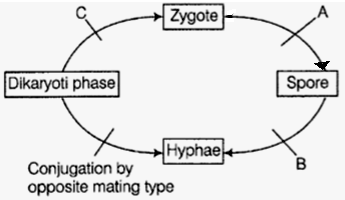Heterocysts present in Nostoc is specialised for
(1) fragmentation
(2) nitrogen-fixation
(3) symbiotic relation
(4) food storage
Refer to the following figures.
Match the following columns and choose the correct option from the codes given below.
|
C-I |
Column I |
Column II |
|
A |
I. Euglena |
I. kinetoplast |
|
B |
II. Paramecium |
II. Trichocysts |
|
C |
III. Trypanosoma |
III. Astaxanthin |
Codes:
|
|
A |
B |
C |
|
(1) |
3-II |
1-III |
2-I |
|
(2) |
1-II |
3-I |
2-I |
|
(3) |
1-III |
2-II |
3-I |
|
(4) |
3-I |
2-II |
1-III |
The given below figure shows a generalised life cycle of a fungus. Identify A, B and C from the given option.

| A | B | C |
(1) | Meiosis | Fertilisation | Meiosis |
(2) | Meiosis | Mitosis | Fertilisation |
(3) | Mitosis | Meiosis | Fertilisation |
(4) | Mitosis | Fertilisation | Meiosis |
Read the following statements regarding archaebacteria.
I. Their cell wall lacks peptidoglycan.
II. They contain membrane bound organelles.
III. These have distinct ribosomal RNA sequence.
IV. Lipid in cell membrane of archaebacteria have different structure than those in all other organisms.
Choose the incorrecct option.
(1) I and II
(2) Only II
(3) Only IV
(4) III and IV
A bacterium divides every 35 minutes. If a culture containing 105 cells/mL is grown for 175 minutes, what will be the cell concentration/mL after 175 minutes?
(1) 5 × 105 cells
(2) 35 × 105 cells
(3) 32 × 105 cells
(4) 4.175 × 105 cells
Dikaryotisation (n + n) in Agaricus is brought about by
(1) clamp connections
(2) somatogamay between two hyphae of different strains
(3) Both (1) and (2) are correct
(4) basidiospores
'Red tide' is caused by
(1) Gonyaulax
(2) Ceratium
(3) Triceratium
(4) All of these
Which one of the following shows heterothallism?
(1) Rhizopus
(2) Bacterium
(3) Cycas
(4) Ricinus
Match items in Column I with those in Column II.
|
|
Column I |
|
Column II |
|
A. |
Peritrichous flagella |
1. |
Ginkgo |
|
B. |
Living fossil |
2. |
Macrocystis |
|
C. |
Rhizophore |
3. |
E.coli |
|
D. |
Smallest flowering plant |
4. |
Selaginella |
|
E. |
Largest perennial alga |
5. |
Wolffia |
|
|
A |
B |
C |
D |
E |
|
(1) |
3 |
1 |
4 |
5 |
2 |
|
(2) |
2 |
3 |
4 |
1 |
5 |
|
(3) |
4 |
2 |
1 |
5 |
3 |
|
(4) |
2 |
4 |
3 |
5 |
1 |
The common characteristic showning by mushroom, smut and rust
(1) is characterised by presence of basidiocarps
(2) is characterised by presence of ascocarps
(3) all are pathogen
(4) all are saprophytic in nature







